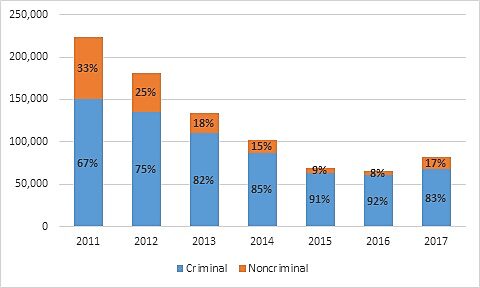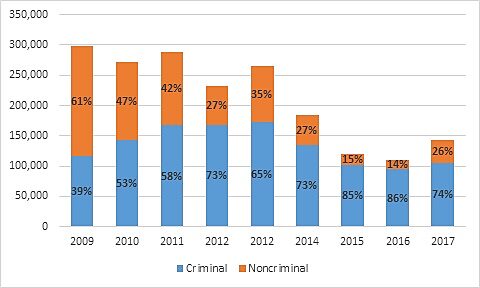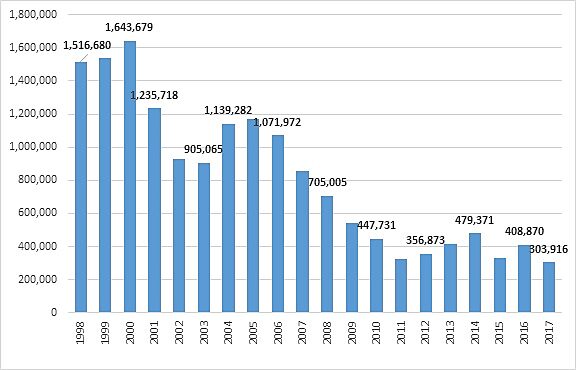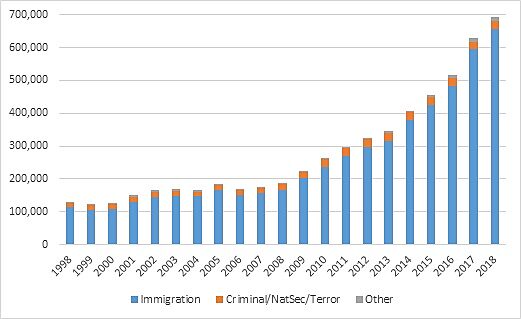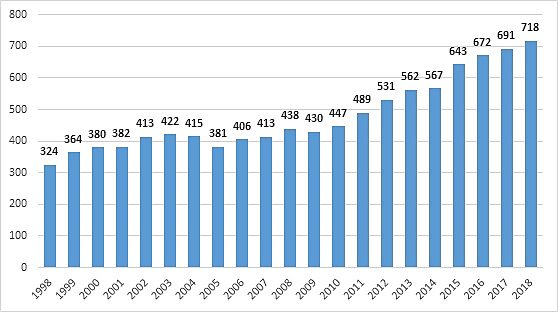President Trump’s administration is ramping up immigration enforcement in the interior of the United States and along the border. However, the near-half-century low in illegal border crossers, the longer-settled illegal immigrant population inside of the country, and resistance by state and local governments are hampering his administration’s efforts to boost deportation. Try as he might, his administration will not be able to ramp up removals to the level seen in the first term of the Obama administration.
Definitions
A removal is defined as when a person is transported outside of the United States because he or she violated the immigration laws. Removals are not technically a punishment under U.S. law as it is a civil penalty and not a criminal one. Some immigration laws are criminal, such as illegal reentry, and those convicted of that crime serve their time in prison and are then removed from the United States. Although not technically a punishment, the effects of removal can often be worse than imprisonment.
Removals encompass unlawfully present foreigners who were apprehended inside of the United States, which is what we commonly think of as “deportations,” and those apprehended while trying to enter the country but who are excluded. Those removed are placed into legal proceedings to be formally expelled from the United States. Returns refers to Mexicans and Canadians who are apprehended at the border and is a less severe and more rapid process. Since the second Bush administration, a much larger percentage of illegal immigrants caught on the border have been removed rather than returned.
All of the years in these charts refer to the fiscal years. For instance, fiscal year (FY) 2017 runs from October 1st, 2016 through September 30, 2017. This presents some limitations for comparing immigration enforcement under the Trump administration with the Obama administration for FY 2017 as Obama was president for the first four months of that year. As a result, the increase in enforcement during the first year of Trump’s administration is undercounted in most of the figures below.
Criminal and Noncriminal Removals and Enforcement
Criminal removals are for those who are convicted of crimes, mostly nonviolent and nonproperty offenses such as violations of immigration law. Much of the fear today is that the Trump administration will increase the removals of noncriminal illegal immigrants. While they certainly are targeted, the number and percentage of noncriminal removals are barely changed in 2017 compared to 2016 (Figure 1). The number of criminal removals climbed by about 11,000 and noncriminal removals by about 3,000 in 2017 relative to 2016.
Figure 1
Criminal and Noncriminal Removals
Source: Immigration and Customs Enforcement.
The removal numbers in Figure 1 include many of those apprehended along the border and removed, a number influenced more by the flow of illegal immigrants into the United States than the intensity of enforcement. Removals from the interior of the United States are the real worry as they could uproot long-settled illegal immigrants and disrupt their families, many of whom include U.S.-born American citizen children. Focusing on removals from the interior of the United States shows that President Trump has more than doubled the proportion who are noncriminals (Figure 2). The number of removals from the interior of the United States was up 25 percent in 2017 over 2016, from 65,332 to 81,603. That is a substantial increase but still far below the annual figures for the first six years of the Obama administration.
Figure 2
Interior Removals by Criminality
Source: Immigration and Customs Enforcement.
Criminal removals as a percent of all removals increased at the beginning of the Trump administration from 50 percent in December 2016 to 59 percent in March 2017, but those are only a few months and more complete data is necessary to fully understand when Immigration and Customs Enforcement (ICE) started to focus more on noncriminals (Figure 3).
Figure 3
Criminal Removals at Beginning of Trump Administration
Source: Immigration and Customs Enforcement.
The Trump administration is flexing its immigration enforcement muscles by ramping up arrests. ICE arrested about 33,000 more people in 2017 than in 2016, representing a 30 percent increase (Figure 4). Furthermore, a far greater percentage of those arrests were noncriminals—26 percent versus 14 percent. To put this in perspective, the percentage of criminal arrests in Trump’s first year is similar to 2014 during the Obama administration although Obama’s ICE arrested more people overall. Furthermore, ICE ERO administrative arrests during Trump’s first year were about half of the number of those during Obama’s first year and the entire difference was that Obama arrested more noncriminals. Comparing ERO administrative arrests for January 20, 2017 through September 30, 2017 to January 20, 2016 through September 30, 2016 shows an even sharper increase of 42 percent from 77,806 to 110,568.
Figure 4
Enforcement and Removal Operations Administrative Arrests
Source: Immigration and Customs Enforcement.
ICE relies heavily on detainers that it places on immigrants apprehended by other law enforcement agencies. These detainers request that the agency holding the immigrant delays their release for a period of time so that ICE can take custody for removal. The number of detainers is also based on federal immigration enforcement priorities which have been widened to all illegal immigrants under the Trump administration. Consequently, the number of detainers that ICE issued increased by 56 percent from December 2016 to November 2017 (Figure 5).
Figure 5
ICE Detainers by Month
Source: Transactional Records Access Clearinghouse.
Border Apprehensions
The Trump administration is expanding interior immigration enforcement but its removals will remain below those of President Obama because so many fewer illegal immigrants are entering the United States. Border Patrol apprehensions along the Southwest Border are low by historical standards and likely to keep falling depending on conditions south of the border (Figure 6). The low number of illegal immigrants entering the country significantly reduces the scope for including border removals to pad the total removal numbers. The Trump administration will have to rely on interior removals which will keep their numbers low relative to President Obama.
Figure 6
Border Patrol Apprehensions on the Southwest Border
Source: Customs and Border Protection.
Courts
ERO administrative arrests (Figure 4) are up more than removals (Figure 1) and interior criminal removals (Figure 2). Trump’s administration is trying to increase the number of deportations but an arrest is merely the first part of a long legal process with serious delays. The first is the roughly 692,000 cases delayed in immigration court (Figure 7). In 2018, the average immigration case is pending 718 days before a decision—a month and a half longer than in 2016 (Figure 8). The Trump administration’s insistence on prosecuting all illegal border crossers is making the situation worse despite other efforts to streamline removals. Immigrants have more due process rights than ever before and many of them are not Mexican so it takes longer to remove people from the United States, a delay that is reflected in the immigration court backlogs.
Figure 7
Immigration Court Case Backlog
Source: Transactional Records Access Clearinghouse.
Figure 8
Immigration Court Backlog in Days
Source: Transactional Records Access Clearinghouse.
Conclusion
The Trump administration is desperately trying to increase the number of removals but it is unlikely that they will reach the numbers achieved during Obama’s first term for at least three reasons. First, states and localities are not cooperating with the Trump administration nearly as much as they did during the Obama administration, which will make it harder to identify illegal immigrants. Second, many fewer illegal immigrants are trying to enter the United States so Trump will be unable to pad the numbers with border removals. Third, immigration courts are desperately backlogged so the pace of removals will be slow.

